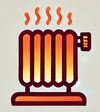Baseboard heater problems often stem from issues like insufficient heat, noise, or leaks. If your heater isn’t warming your space effectively, check for air trapped in the system or a malfunctioning thermostat. Noisy heaters can indicate a buildup of debris or water in the pipes, while leaks may signal a need for professional repair.
Addressing these problems promptly can prevent costly damage and ensure your home stays comfortable. Understanding the common issues with baseboard heaters can help you troubleshoot effectively and maintain a cozy environment during the colder months.
Common Baseboard Heater Problems
Baseboard heaters often face issues that affect their efficiency. It’s crucial to identify and resolve these problems to maintain a comfortable home.
Insufficient Heating
Insufficient heating can stem from several sources.
- Power and Circuit Issues: Check the circuit breaker if the heater doesn’t turn on. A tripped breaker can prevent heat from reaching your space. Ensure the thermostat is set correctly too. Loose connections or damage to the heating element may also limit power flow.
- Obstructions and Vent Blockage: Blockages can hinder airflow. Ensure that furniture or objects aren’t in the way. Cleaning vents and fins regularly keeps dust and debris from reducing efficiency.
- Inadequate Heater Size: Size matters. A heater too small for the room won’t provide sufficient warmth. Consider the square footage when selecting a heater.
- Thermostat Issues: A malfunctioning thermostat can disrupt heating. Check the settings. Replacement might be necessary if adjustments fail to improve heating.
Unusual Noises
Unusual noises from baseboard heaters signal problems that need attention.
- Debris: Dust and debris can cause rattling or banging sounds. Regular cleaning can minimize buildup and noise.
- Water Buildup: Water accumulating in the system may lead to gurgling sounds. This often indicates trapped air. Bleeding the radiator can resolve this issue and restore quiet operation.
Leaking Water
Leaking water from baseboard heaters poses a serious concern.
- Pipe Damage: Check for visible damage to pipes connected to the heater. Cracks or corrosion can lead to leaks. Inspect and repair any damaged pipes promptly to prevent water damage.
- Connection Issues: Loose connections can also cause leaks. Ensure all fittings are snug. Tightening can often resolve minor leaks.
- Heater Integrity: Inspect the heater itself for signs of rust or wear. These issues may indicate the need for replacement to avoid further leaks.
Troubleshooting Baseboard Heater Issues
Baseboard heaters can face various problems. Troubleshooting these issues helps maintain comfort in your home. Focus on these key areas for effective solutions.
Checking Thermostats
Check the thermostat settings first. Set the thermostat to your desired temperature. If your heater won’t turn on, the thermostat may be faulty. If your heater keeps running when the room feels warm, you may need to calibrate or replace the thermostat.
Test the thermostat by lowering the setting to the minimum. If the heater still operates, the thermostat likely has a defect. Examine the wires behind the thermostat faceplate. Loose or damaged wires can lead to malfunction.
Inspecting for Blockages
Inspect the heater for obstructions. Ensure that vents and fins are free from furniture, drapes, or other items. Blockages restrict airflow and reduce heating efficiency.
Clean your heater regularly to remove dust and debris. Accumulated dirt can cause overheating and decrease performance. Use a soft cloth or vacuum attachment to clear any buildup.
Assessing Electrical Connections
Examine the electrical connections next. Ensure that wiring is secure and intact. Look for signs of wear or damage on wires. Damaged wires can disrupt power flow to the heater.
Check the circuit breaker as well. A tripped breaker can prevent the heater from operating. Reset the breaker if necessary. If issues persist, consider contacting a professional for a detailed inspection.
Maintenance Tips for Baseboard Heaters
Regular maintenance keeps baseboard heaters functioning efficiently. Take proactive steps to ensure they provide consistent warmth.
Regular Cleaning
Regular cleaning is essential for baseboard heaters. Dust and debris can block airflow, reducing efficiency. Use a soft cloth or a vacuum with a brush attachment to clean the heater fins. This should happen at least once a season. Make sure to also wipe down the surface to remove dust buildup. Checking the area around the heater is vital. Ensure no furniture or drapes obstruct airflow. If you notice an accumulation of dust, increase your cleaning frequency. Clean vents help maintain optimal performance.
Inspecting Valves and Fittings
Inspecting valves and fittings is crucial for heater efficiency. Check for leaks or damage that might affect operation. Tighten any loose connections immediately. Ensure that the valves function properly; they must open and close without sticking. A faulty valve can lead to inadequate heating. Schedule a checkup every year to catch potential problems early. If you notice irregularities, considering a professional assessment can ensure the system runs smoothly and safely.
When to Call a Professional
Some heater issues require expert assistance. If troubleshooting doesn’t resolve the problem, it’s time to contact a professional. Certain signs indicate a need for expert help.
Signs You Need Expert Help
- Persistent Issues: If the heater keeps malfunctioning after DIY efforts, call for help.
- Unusual Sounds: Hearing strange noises, like clanking or hissing, usually suggests a more serious problem.
- Excessive Heat: If the heater overheats even though cleaning and checks, it could indicate a dangerous fault.
- Water Leaks: Water pooling around the heater often points to broken pipes or connections that need repair.
- Burning Smells: A burning odor, even after cleaning, can signal overheating components or electrical issues.
Recognizing these signs early can prevent bigger problems down the line.
Choosing the Right Technician
Choose a technician with experience in baseboard heating systems. Look for certifications and positive reviews. Ask about their familiarity with your specific heater model. Obtain quotes from multiple professionals to compare prices and services. Ensure the technician you pick is licensed and insured. This adds an extra layer of protection in case of further issues.
Establish clear communication about your heater’s problems. Detailed descriptions of issues can help them diagnose effectively. Trust the expert’s advice on needed repairs or maintenance.
Conclusion
Addressing baseboard heater problems promptly is essential for maintaining a warm and comfortable home. Regular maintenance and inspections can prevent many common issues from escalating into costly repairs. By staying proactive and following the troubleshooting tips outlined, you can ensure your heating system operates efficiently.
If you encounter persistent problems or unusual signs, don’t hesitate to call a professional. Their expertise can provide peace of mind and restore comfort to your space. Remember, a well-maintained heating system not only enhances your comfort but also contributes to energy efficiency, saving you money in the long run. Keep your home cozy this winter by taking care of your baseboard heaters.








